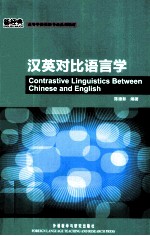图书介绍
汉英对比语言学【2025|PDF下载-Epub版本|mobi电子书|kindle百度云盘下载】

- 陈德彰著 著
- 出版社: 北京:外语教学与研究出版社
- ISBN:9787513512916
- 出版时间:2011
- 标注页数:354页
- 文件大小:15MB
- 文件页数:369页
- 主题词:汉语-对比语言学-英语-高等学校-教材
PDF下载
下载说明
汉英对比语言学PDF格式电子书版下载
下载的文件为RAR压缩包。需要使用解压软件进行解压得到PDF格式图书。建议使用BT下载工具Free Download Manager进行下载,简称FDM(免费,没有广告,支持多平台)。本站资源全部打包为BT种子。所以需要使用专业的BT下载软件进行下载。如BitComet qBittorrent uTorrent等BT下载工具。迅雷目前由于本站不是热门资源。不推荐使用!后期资源热门了。安装了迅雷也可以迅雷进行下载!
(文件页数 要大于 标注页数,上中下等多册电子书除外)
注意:本站所有压缩包均有解压码: 点击下载压缩包解压工具
图书目录
Chapter 1 Language and Thinking1
1.1 Introduction1
1.1.1 Definition of language1
1.1.2 Characteristics of language3
1.2 Comparison of English and Chinese3
1.2.1 Reason for contrastive studies between English and Chinese3
1.2.2 A preliminary comparison4
Chapter 2 Words and Characters20
2.1 English letters and Chinese characters20
2.2 Development of Chinese characters26
2.3 The relation between Chinese characters and words31
2.4 Motivation of words41
2.5 Meaning of words45
2.6 Word as a unit56
Chapter 3 Primal Words and Secondary Words59
3.1 Introduction59
3.2 Formation of secondary words60
3.2.1 Combining61
3.2.2 Examples of a special type of derivation61
3.2.3 Compounding74
3.3 Shortening76
3.3.1 Acronym76
3.3.2 Blending78
3.3.3 Clipping81
3.3.4 Shortening of Chinese words82
3.4 Other means of new word formation87
3.4.1 Conversion87
3.4.2 Borrowing88
3.5 Analogy97
Chapter 4 Intonation and Tone101
4.1 Intonation101
4.2 Syllable103
4.3 Sound effect of poems109
Chapter 5 Conception and Nomenclature114
5.1 Lexical disparity114
5.2 Lexeme gap115
5.2.1 Different motivations behind nomenclature115
5.2.2 Different ways of grouping things120
5.2.3 Differences among synonyms124
5.2.4 Things unique to a culture126
5.3 Semantic gap128
5.3.1 Different reference meanings128
5.3.2 Different extended meanings134
5.3.3 Different directions of meanings135
5.4 Usage Gaps137
5.4.1 Transitivity137
5.4.2 Differences caused by word formation139
5.4.3 Differences caused by flexible usage—conversion140
5.4.4 Differences caused by different grammatical meanings between corresponding words141
Chapter 6 Abstraction and Concretion147
6.1 Abstraction and abstract meaning147
6.2 杯as an example150
6.3 Further abstraction159
6.4 Abstraction and sentence structure165
6.5 Concretization of abstract nouns168
Chapter 7 Stativeness and Dynamicity174
7.1 Introduction174
7.2 The verb175
7.2.1 Functions of verbs176
7.2.2 Classification of verbs177
7.2.3 Morphological changes of English verbs181
7.2.4 The use of verbs in the sentences182
7.3 Verbalization of nouns185
7.4 Action or motion implied in other parts of speech192
7.4.1 The noun192
7.4.2 Other parts of speech201
7.5 At the syntactic level204
Chapter 8 Overtness and Covertness212
8.1 Markers212
8.2 Parts of speech and their function in the sentence214
8.3 The article222
8.4 Marker of the plural231
8.5 Chinese auxiliaries的,地,and得238
8.5.1 的238
8.5.2 地241
8.5.3 得242
8.6 The passive246
8.7 Punctuation marks248
Chapter 9 Rigidity and Flexibility251
9.1 General difference between Chinese and English grammar251
9.2 Definition of the sentence252
9.3 Classification of sentences256
9.3.1 Some special Chinese sentence patterns267
9.4 Elements of the sentence273
9.4.1 The subject273
9.4.2 Relation between the verb and its object285
9.5 Word order292
9.5.1 Adverbials296
9.5.2 Relative clauses302
9.5.3 Inversion304
9.6 Parataxis and hypotaxis309
9.6.1 Connectives310
Chapter 10 Objectivity and Subjectivity330
10.1 Language and subject330
10.2 Daily usage of the language333
10.3 Subjective and objective standards335
10.4 Depiction of mental activities in English338
10.5 The passive voice341
10.6 Animated and inanimate subjects343
10.7 Different levels of objectivity345
Bibliography349
Recommended Readings351
热门推荐
- 3884067.html
- 2364908.html
- 2316612.html
- 3486730.html
- 1885349.html
- 540643.html
- 762786.html
- 661662.html
- 1854552.html
- 1011159.html
- http://www.ickdjs.cc/book_1833657.html
- http://www.ickdjs.cc/book_3485794.html
- http://www.ickdjs.cc/book_2416206.html
- http://www.ickdjs.cc/book_2000372.html
- http://www.ickdjs.cc/book_3431885.html
- http://www.ickdjs.cc/book_1720703.html
- http://www.ickdjs.cc/book_1262660.html
- http://www.ickdjs.cc/book_3094291.html
- http://www.ickdjs.cc/book_2935496.html
- http://www.ickdjs.cc/book_2292292.html